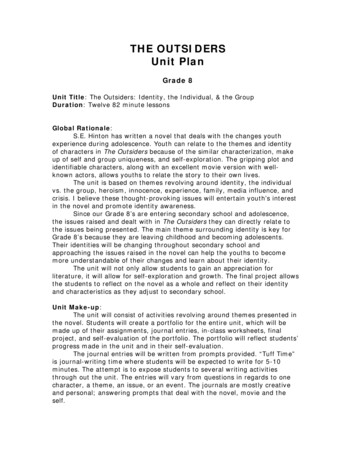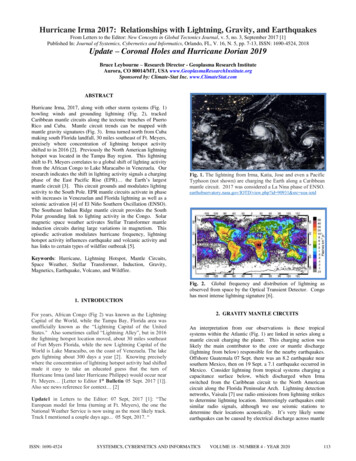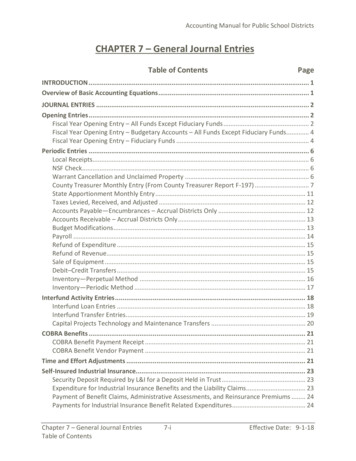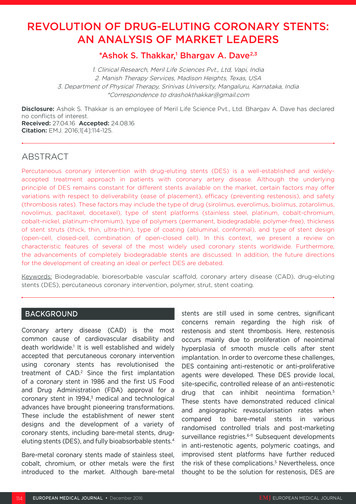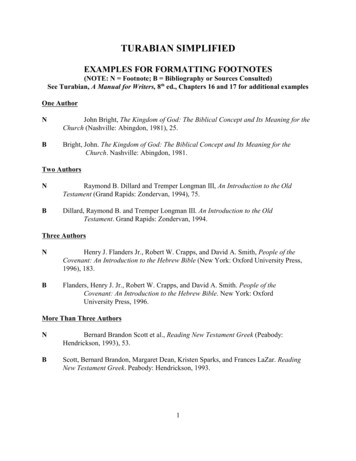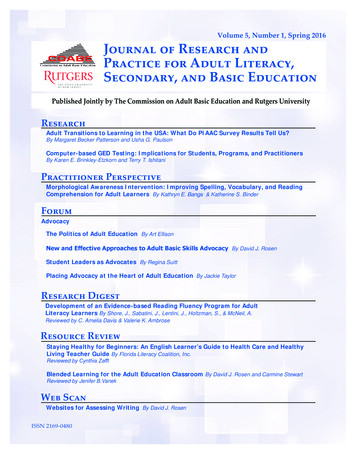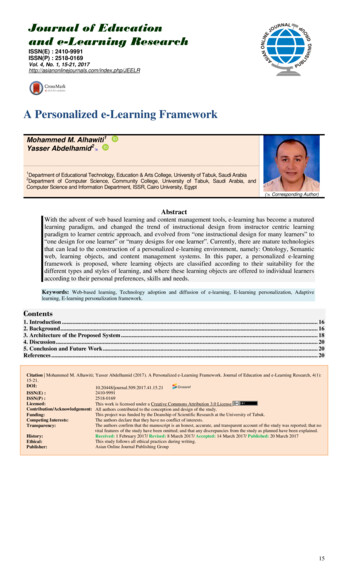
Transcription
Journal of Educationand e-Learning ResearchISSN(E) : 2410-9991ISSN(P) : 2518-0169Vol. 4, No. 1, 15-21, A Personalized e-Learning FrameworkMohammed M. Alhawiti1Yasser Abdelhamid2 1Department of Educational Technology, Education & Arts College, University of Tabuk, Saudi ArabiaDepartment of Computer Science, Community College, University of Tabuk, Saudi Arabia, andComputer Science and Information Department, ISSR, Cairo University, Egypt2( Corresponding Author)AbstractWith the advent of web based learning and content management tools, e-learning has become a maturedlearning paradigm, and changed the trend of instructional design from instructor centric learningparadigm to learner centric approach, and evolved from “one instructional design for many learners” to“one design for one learner” or “many designs for one learner”. Currently, there are mature technologiesthat can lead to the construction of a personalized e-learning environment, namely: Ontology, Semanticweb, learning objects, and content management systems. In this paper, a personalized e-learningframework is proposed, where learning objects are classified according to their suitability for thedifferent types and styles of learning, and where these learning objects are offered to individual learnersaccording to their personal preferences, skills and needs.Keywords: Web-based learning, Technology adoption and diffusion of e-learning, E-learning personalization, Adaptivelearning, E-learning personalization framework.Contents1. Introduction . 162. Background . 163. Architecture of the Proposed System . 184. Discussion . 205. Conclusion and Future Work . 20References . 20Citation Mohammed M. Alhawiti; Yasser Abdelhamid (2017). A Personalized e-Learning Framework. Journal of Education and e-Learning Research, SSN(E) :ISSN(P) peting 410-99912518-0169This work is licensed under a Creative Commons Attribution 3.0 LicenseAll authors contributed to the conception and design of the study.This project was funded by the Deanship of Scientific Research at the University of Tabuk.The authors declare that they have no conflict of interests.The authors confirm that the manuscript is an honest, accurate, and transparent account of the study was reported; that novital features of the study have been omitted; and that any discrepancies from the study as planned have been explained.Received: 1 February 2017/ Revised: 8 March 2017/ Accepted: 14 March 2017/ Published: 20 March 2017This study follows all ethical practices during writing.Asian Online Journal Publishing Group15
Journal of Education and e-Learning Research, 2017, 4(1): 15-211. IntroductionIn e-learning environments, instructional design has evolved from one instructional design for many learners toone design for each learner or many designs for each learner (Chorfi and Jemni, 2003). It is a fact that learners havevarying characteristics and skills that affect the way they learn best.In order to fulfill this target, many learning sequences should be developed for the same course using differentcourse components. For these components to be reusable, they have to be designed in a way that makes it selfcontained, and small enough to facilitate its reuse in different contexts. According to this view, a huge number ofcomponents will be generated, and the problem will be to locate the required components and to put them in theirplace in the intended sequence of learning. To facilitate searching for learning components, each component needs tobe marked with information that identify its different aspects including its subject matter information and otherproperties that characterize each of these components. A standard model of the produced learning components mustbe used to support its sharing and reuse among the community of learning courses authors. Also, the terminology andvocabulary used to describe the learning components must be unified.To enable machines to help the authors in building learning sequences, data about components and theirproperties should be modeled and encoded in a machine exchangeable form. There must be an intelligent processthat can match the characteristics of available learning components against those of the individual learners. Thisprocess will use its knowledge about the characteristics of learners and help them in adapting the learning sequencethat suits their preferences. Although it is a complicated process, the authors believe that the current informationtechnologies are able to fulfill the aforementioned requirements. Utilization of these technologies come in fourstages: Authoring, Characterization, Delivery, and Feedback.At the authoring stage, the course designer needs a system that helps in building the structure of the intendedcourse, that is breaking down the course into a number of modules, each module is divided into a number of lessons,and finally each lesson is represented by a number of learning objects which are the primitive components to bedelivered to the learner. Learning content management system is the suitable tool for this stage, as it provides all theauthoring and design facilities for the course designer to build and organize his/her course. Characterization stageinvolves description, tagging, and classification of learning objects, this stage will allow learning objects to be sharedor reused in different courses. Ontology provides the possibility to describe learning objects by formally specifyingits characteristics. This will allow for founding the language that will be used later in the delivery stage for matchingthe properties of learning objects against the personal characteristics, skills and preferences of the learner, andsuggesting the most suitable learning objects for them. Finally, the feedback stage is needed to build the knowledgeupon which specific learning objects are recommended for each individual learner, either according to the learner‟sown previous selections and preferences, or according to those of other similar learners who have similarpreferences.This research project introduces the layout of a proposed framework that combines learning objects, ontology,semantic web, and content management systems to enable the delivery of a personalized course plan for eachindividual learner. In section 2, the authors provide a sufficient background about ontology, learning objects,semantic web, and content management systems. In section 3, the layout of the proposed framework is introduced.Finally, section 4 is for discussion and conclusions.2. BackgroundCurrent technology has the potential to construct an e-learning environment that is capable of acquiringpreferences of learners, building and managing sharable and reusable semantically modeled learning entities, andproviding customized e-learning services for each individual learner according to his/her preferences and personalcharacteristics. These technologies are: learning objects, ontology, semantic web, and content management systems.In addition to introducing the concept of e-learning personalization, the reader will be provided with an adequatecoverage about each of these technologies and the role of each of them in the proposed framework.A. Personalized e-LearningPersonalization in e-learning is an education related technology that provides the possibility of creating differentlearning sequences for the different learners, based on their personal needs and preferences (Devedžiü, 2006).Researchers have adopted different strategies for achieving personalization in e-learning domain. For example,PERSO recommends courses to be provided to learners according to their level and their media preferences usingCase Based Reasoning (CBR) (Chorfi and Jemni, 2003). Tools for building personalized hyper books, likeMetalinks, has been used to build a geology personalized hyper book according to the learner‟s level of knowledge,media preferences and learning goals (Murray, 2003). Course planning tools like PASER, have been used forbuilding personalized course plans based on learners‟ goals and their level of knowledge using domain ontology(Kontopoulos et al., 2008). Web mining was another technique that have been used to deliver learning content tolearners according to their preferences and needs (Khribi et al., 2007).It is worth mentioning that not only learner‟s preferences determine the appropriate personalization strategy, butalso learning courses characteristics and teachers‟ preferences are among the factors that affect the selection of suchstrategies (Essalmi et al., 2010; Essalmi et al., 2010).B. Learning ObjectsRecently, sharing and reuse of learning content has gained a lot of interest that led to the emergence of theconcept of learning objects. Inspired by the idea of object-oriented programming, the idea of learning objects is tobuild learning courses using libraries of small blocks, these blocks are self-contained reusable components that areassociated with metadata to facilitate its sharing and reuse (Duval, 2002).Traditional learning content came into large blocks that made it hard to include it in any learning sequence other16
Journal of Education and e-Learning Research, 2017, 4(1): 15-21than the original intended one. Small size and self-containment are among the most characterizing features oflearning objects. As learning component gets smaller, its chance for being reused in different contexts and differentlearning sequences becomes larger, and the more it becomes self-contained and independent of other components,the more it becomes easy to reuse in different contexts. Learning objects can also be grouped in larger collections toconstruct other larger bodies of learning structures.In addition to the subject matter learning content included in the learning object, there are other information andmetadata that are used to facilitate locating and searching for them. Learning object metadata may includeinformation like type of learning object, format, and teaching or interaction style. Learning objects can be classifiedinto presentation objects, which introduce specific subject matter through direct instruction and presentationresources, practice objects, which allow learning of certain procedures through practical activities like drill,interactive applications, educational games or representations that allow practice and learning of certain procedures,simulation objects, which allow learning through virtual representation of processes and real-life systems, conceptualmodels, which allow learning of key concepts related to a specific subject matter, information objects, which allowlearning by displaying information organized and represented with modalities, and contextual representation, that isdata displayed as it emerges from represented authentic scenario (Churchill, 2007).C. OntologyOntology is the explicit formal specification of terms and the relationship between them in a specific domain(Gruber, 1993). It defines a common vocabulary for researchers to share information in a specific domain, andincludes machine-interpretable definitions of basic concepts and their relationships in that domain. Ontology isbecoming of increasing importance to a large number of applications, such as knowledge-based systems, informationexchange, the semantic web, and application integration. Many disciplines have developed their own standardontologies that domain experts can use to share and annotate information in their fields.Ontology is considered to be a highly suitable means of supporting educational-technology systems (Mizoguchiand Bourdeau, 2000; Aroyo et al., 2002). The increasing importance of the semantic web, which is based onontology, is strengthening this argument (Berners-Lee et al., 2001). It has a promising role in the field ofinstructional design and the development of course content, as it can represent knowledge about content, supportscourse authors in creating content and provides easy accessibility of course content by students. Hence, it is stronglyexpected that ontology might be useful in the domain of education (Boyce and Pahl, 2007).Ontologies for the Use of digital learning Resources and semantic Annotations on Line (OURAL) is a researchproject that defines ontology in the e-learning domain including problem-situation, problem solving, critical analysis,case study, debate, cyber quest, project, exercise, etc (Grandbastien et al., 2007).Ontologies for e-learning systems in higher education (Bucos et al., 2010) is a semantic web that wasimplemented using Protégé-OWL and defines user profile ontology, the person ontology, the contact ontology andeducational activities ontology among other classes in the domain of higher education.Information and Communication Technologies (ICT) in education ontology (Chin and Chang, 2011) provides acentral repository of classified knowledge of ICT in the education domain. ICT ontology consists of concepts likeICT curriculum, ICT job, ICT skill and ICT research.European credit vocational system (Yang and Chen, 2010) uses ontologies in the construction of the educationalresources library, to provide a common access to the information regarding the qualification systems of nineEuropean countries.A number of recent studies in the domain of e-learning development focused on the use of ontology insupporting adaptive learning and personalization of course content (Sedleniece and Cakula, 2012). The idea is basedon the fact that every learner prefers certain types of training material according to his/her personal learning style,needs and interests, and ontology can fill the gap to structuring course content in a way that facilitates easy deliveryof course content to different styles of individual learners. Ontology can help learners to use learning contents thatmatch their personal preferences by using information that has formal specific meaning about these learningcontents. Ontology also can be used for imposing a structure on the learning contents of a specific subject whichhelps both the instruction designer and the learner in the learning process.D. Semantic WebThe World Wide Web (WWW) has a huge amount of documents and lots of information, only accessible byhuman users. Knowledge in the Internet is notorious for its vastness, semantically duplicated terms, vagueness,incompleteness, uncertainty, and inconsistency. Search engines currently use keyword searches within thesedocuments to find text that a user is looking for. Computers cannot understand the contents of the documents; theycan only present their contents. To enable machines to understand information published in the web documents, theremust be a way for giving this information well-defined meanings. This will enable also better communicationbetween human and machines.The semantic web provides a mechanism for formatting data into machine readable form, describing individualdata using properties defined in globally accessible schemas, matching local references to entities against variouskinds of standard names, and enabling a range of inferences over data in scalable ways.The semantic web uses a data model named RDF (Resource description Framework) that is based on the idea ofmaking statements about resources in web sites. The statements are constructed in the form of (Subject, Predicate,Object) triples, where Subject represents a resource, Predicate represents a property of the resource, and Object is avalue of the property in form of a resource or a literal. Semantic Web technologies such as RDFa (Adida andBirbeck, 2008) allow webpage designers to embed RDF in their webpages for encoding information to be processedby machines. The RDF set of triples builds a directed graph, called RDF graph, where the subject and object arenodes and the predicate is a labeled directed edge from the subject to the object.17
Journal of Education and e-Learning Research, 2017, 4(1): 15-21E. Content Management SystemsA content management system is a kind of software that allows creation of learning content as well as providingall the functions required to modify, organize, delete, or publish that content. It is also capable of managingworkflow in a shared and collaborative environment (Rockley et al., 2003; White, 2005; Tseng et al., 2008).Learning management systems are varying from just management of educational information to delivery of onlinelearning content, and other features including collaboration, sharing, result analysis, and many other features. Twotypes of learning systems must be distinguished: Learning Management Systems (LMS), and Learning ContentManagement Systems (LCMS). Learning management systems control management and delivery of online courses,in addition to other tasks related to the management of student records, and tracking their performance. Learningcontent management systems are software environments that provide the facilities of developing, storing, managing,reusing and delivery of learning content repositories. Using LCMS, course development is never done entirely fromscratch. It provides the facility of rapidly assembling courses out of reusable objects stored in the shared learningcontent repository.Products of LMS may include student administration and registration, activity event management, reporting,certification management, and performance tracking, while LCMS products may include functionalities likecollaborative content management, workflow integration, publishing and template driven content development.F. Adaptive Learning Management SystemsAdaptive learning has gained increased attention in the last few years, many research efforts have beenforwarded to experimenting the idea and proving its efficiency. In 2008 a research group developed an adaptivelearning system based on personalization information, learning behavior and personal learning style (Tseng et al.,2008). They conducted an experiment to evaluate the performance of the proposed model. The results revealed thatthe proposed approach can be helpful in improving both the learning achievement and learning efficiency ofindividual students. In 2014, a research group applied activity theory to design an adaptive e-learning systems,where the activity theory is a framework to study human‟s behavior at learning. They concluded that activity theoryis a useful framework to design adaptive e-learning systems and provide student-centered education (Peña-Ayala etal., 2014).(SDAL) is a novel Statistical sub-Domain Adaptation Learning framework. The proposed frameworkconcentrated on problems such as improving the efficiency of the algorithms to set the parameters that affect learningmethods (Gao et al., 2015).G. Learning StylesLearning styles are ways of learning. A preferred learning style is the way in which a student learns best, whichreflects the relative strengths or weaknesses of that student‟s underling cognitive learning skills. There are manyresearch efforts that assert the fact that students and trainees learn effectively with teaching methods that fulfill theirlearning preferences (Li et al., 2008). Learning style can be defined as the cognitive characteristics, affective andpsychological behaviors that indicate the way learners perceive, interpret and react to learning environments (Honeyand Mumford, 1992). They are also defined as the composite of cognitive characteristics, affective and psychologicalfactors that influence the way individuals interact and respond to learning environments (Duff and Duffy, 2002).Research on learning styles has been approached from different perspectives including web-based educationperspective on learning style (Garcia et al., 2007) aesthetic experience (Welsh et al., 2007) using business casestudies in learning process (Duff et al., 2008) problem-solving strategies within learning styles (Metallidou andPlatsidou, 2008) preferred learning styles (Peters et al., 2008) and adaptive learning system perspective of learningstyles (Tseng et al., 2008).Multiple Intelligence (MI) theory indicates that there are at least seven learning styles including Interpersonal,intra-personal, body/kinesthetic, visual/spatial, logical/mathematical, verbal/linguistic, and musical/rhythmic. Recenteducational literature, focus on a simplified list of learning styles: Auditory, Visual, and Tactile (Lazear, 1991).A student with an auditory learning style learns best when information is delivered in auditory formats such aslectures, discussions, oral readings, audio recordings, or podcasts. Auditory learners do well in classroom settingswhere professor lectures and student discussions are the norm. These students also do well with taped courses andgroup study situations. A student with a visual learning style learns best when information is presented in visualformats such as books, articles, web pages, images, videos, or diagrams. Visual learners do well with class handouts,power point presentations, movies, and chalkboards. These students take detailed notes, highlight their texts, and useflow charts for study aids. A student with a tactile learning style learns best when information is conveyed in “handson” settings such as trade positions, labs, workshops, or participatory classes. Tactile learners respond well totouching and creating things in areas such as art and science. These students want to hold and manipulate the subjectmatter, rather than merely viewing its image (Gilakjani, 2012).3. Architecture of the Proposed SystemThe proposed framework integrates the capabilities of content management systems, ontology, semantic web,and learning objects to build an adaptive e-learning environment. The main target of the proposed framework is toproduce standardized repositories of sharable and reusable learning objects that can be used to personalize theprocess of e-learning for the individual learners by acquiring their personal characteristics, and preferences, andadapting their learning plan according their specific characteristics. This section introduces a description of theoverall architecture of the proposed framework, and the role of each of its components.As shown in Figure I the proposed framework consists of four main modules: learning content authoring module,tagging module, intelligent personalization module, and learning content delivery module.18
Journal of Education and e-Learning Research, 2017, 4(1): 15-21A. Learning Content Authoring ModuleThe learning content authoring module is a sub-system of the learning content management system that providesthe facilities of creating, modifying, and managing learning objects. The learning object can be described in twoways: The asset or the content of the learning object in the form of video tutorials, presentations, text notes, traininginstructions etc , and the learning object metadata which adds information about the learning objects in the form oftags and helps in easily locating them. Learning objects with effective meta-tags facilitate content maintenance,search, and management. They also allow for immediate customization of course content based on criteria that thelearner selects.The institute of Electrical and Electronics Engineers standards association (IEEE) has published a standard forLearning Object Metadata (IEEE 1484.12.1 – 2002), for the description of learning objects. According to this model,attributes of learning objects have been classified into nine main categories including general attributes like title,language and description, and technical information like format, size and location, and educational attributes likeinteractivity level, learning resource type, and context, and many other attributes that describe the different aspects ofthe learning object.Figure-I. Proposed e-learning personalization frameworkB. Tagging ModuleTagging is the process of adding special annotations or marks that attach a piece of information to a resource oran object for future referral. There are many purposes for tagging objects, users usually tag objects for the purpose offuture retrieval of the objects by themselves or by others. They also use tags for sharing their ideas about objects withother users, or to attract attention to specific resources, or to put self-referential tags to mark their contributions, or toput an evaluation for a specific object (Gupta et al., 2010).This sub-system uses ontology for attaching meta-data to each learning object. Generally, there are two types ofontology that can be used by the tagging module: Course subject ontology, and Learning ontology. Course subjectontology includes knowledge related to the concepts of a specific learning course subject and the relations betweenthem, while learning ontology includes knowledge related to the concepts of learning as a general domain and therelations between them. Tagged learning objects are stored in a repository to be used by the learners through thedelivery module.C. Intelligent Personalization ModuleIn the previous stage, learning objects are attached with subject ontology tags and learning ontology tags. Theintelligent personalization module uses these tags for determining which of these learning objects is suitable for eachlearner. By determining the learning style of the learner as well as his/her previous feedback about consumedlearning objects, the intelligent personalization module will be able to set the characteristics of learning objects thatmatch the preferences of the learner.D. Learning Content Delivery ModuleThe content delivery module is the front end system that deals directly with the learner. In addition to offeringlearning sequences to the learner, the proposed content delivery module keeps a record of the learning objectsconsumed by each learner, and the feedback that can be used in dynamically adapting his/her learning sequence.19
Journal of Education and e-Learning Research, 2017, 4(1): 15-214. DiscussionThe old days of having one instructional design for all learners has gone. Learners with different learning stylesneed different learning sequences to elevate their performance in the learning process. Current e-learning andinformation technologies has the potential to support multiple instructional designs for different learners if it isintegrated properly. Learning objects, and learning management systems have been around many years ago but thepersonalization requirement couldn‟t be fulfilled since a huge amount of work is needed to be done by the authors ofthe e-learning courses.This research project addresses this requirement and introduces ontology and the semantic web technologies fordoing the hard work of classifying the produced learning objects, acquiring preferences of individual learners andusing this information in determining the most suitable learning objects for each individual learner. The proposedframework is organized into four stages: Authoring, Characterization, Delivery, and Feedback. At the authoringstage, a learning content authoring module is used for building learning objects using a standard learning objectmodel to support sharing / reuse. At the characterization stage, the tagging module is used for adding meta-dataextracted from subject matter ontology and learning domain ontology to characterize each learning module accordingto its content, and relevance to specific styles of learning. At the delivery stage, an intelligent personalization moduleis used to search learning object repositories for the most suitable elements according to the preferences of thelearner, and forward them to the learning content delivery module that is responsible for both recommending theselearning objects to the learner and acquiring his/her learning style, and preferences to be taken in consideration inconsequent adaptation of his/her learning sequence.5. Conclusion and Future WorkThis research has drawn a road map for building a fully personalized e-learning system. The used technologieswere around long ago, but haven‟t been integrated in a way that fulfills the personalization target. Future research inthis area will include the following: Implementation of a learning objects authoring tool based on the structure of the (IEEE 1484.12.1 – 2002)standard, to support sharing and reuse of learning objects. Implementation of course / subject ontology building tool that helps in constructing the concepts related to aspecific subject and the relations between them. Implementation of a learning ontology building tool that helps in constructing the concepts of learning andthe relations between them. Implementation of learning objects characterization system that uses the related ontology in characterizinglearning objects and keeping them in searchable repositories. Implementation of an intelligent personalization system that acts as an agent that takes care of thepreferences of the learner and searches
In e-learning environments, instructional design has evolved from one instructional design for many learners to one design for each learner or many designs for each learner (Chorfi and Jemni, 2003). It is a fact that learners have varying characteristics and ski



